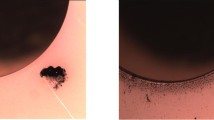Abstract
Handheld FM-200, FE-36, CF3I and Halotron I extinguishers with 2B:C, 5B:C and 10B:C ratings (or equivalent) were tested for extinguishing Class B heptane pool fires in small and large enclosures (45, 120 and 21000 m3). Test results showed that the Halotron I and CF3I extinguishers performed better than the FE-36 and FM-200 extinguishers. The concentrations of the halocarbons and acid gas by-products in the operator breathing zone and surroundings were measured during the tests. Measurements showed that the agent concentrations were below the levels that would pose life or health risk to the operator. The concentrations of acid gas by-products generated during suppression, however, were at dangerous levels in the small enclosures (45 and 120 m3). Heat flux towards the operator was also measured. Heat exposure presented a severe hazard to the operator during the pool fire suppression. Test results indicate some potentially hazardous conditions to an unprotected operator.
Similar content being viewed by others
References
W.M. Pitts, M.R. Nyden, R.G. Gann, W.G. Mallard, and W. Tsang, Construction of an Exploratory List of Chemicals to Initiate the Search for Halon Alternatives, NIST Technical Note 1279, Gaithersburg, MD: National Institute of Standards and Technology, 1990.
P.O. Huston, “Halon 1211 Replacement Agents, A Long Time in Development, Are Now Available,” Proceedings of International Conference on Ozone Protection Technologies, Washington, DC, 1996, pp. 609–614.
T.A. Moore, and J.L. Lifke, “Evaluation and Testing of Clean Agents for U.S. Army Combat Vehicle Portable Fire Extinguishers,” in Proceedings of Halon Options Technical Working Conference, Albuquerque, NM, 1997, pp. 453–466.
S.R. Skaggs, and M.A. Cecil, “Exposure Assessment to TriodideTM in Streaming Scenarios,” in Proceedings of International CFC And Halon Alternatives Conference, Washington, DC, 1995, pp. 561–569.
S.R. Skaggs, D.S. Dierdorf, and S. Newhouse, “Recent Progress in TriodideTM Commercialization,” in Proceedings of International Conference on Ozone Protection Technologies, Washington, DC, 1996, pp. 631–639.
S.R. Skaggs, and R. Rubenstein, “Setting the Occupational Exposure Limit for CF3I,” in Proceedings of Halon Options Technical Working Conference, Albuquerque, NM, 1999, pp. 254–261.
W.C. McCain, and J. Macko, “Toxicity Review for Iodotrifluoromethane (CF3I),” in Proceedings of Halon Options Technical Working Conference, Albuquerque, NM, 1999, pp. 242–253.
T.A. Moore, J.L. Lifke, and R.E. Tapscott, “In Search of an Agent for the Portable Fire Extinguisher,” in Proceedings of Halon Options Technical Working Conference, Albuquerque, NM, 1996, pp. 387–398.
J.A. Pignato, Jr. and J.F. Ruffing, “Perfluorohexane Clean Extinguishing Agent for Streaming and Local Application Systems,” in Proceedings of Halon Options Technical Working Conference, Albuquerque, NM, 1994, pp. 307–317.
J.A. Wright, “Full Scale Test Evaluations of Halon 1211 Replacement Agents for Airport Fire Fighting,” in Proceedings of Halon Options Technical Working Conference, Albuquerque, NM, 1994, pp. 295–306.
J.A. Wright, Full-Scale Evaluations of Halon 1211 Replacement Agents for Airport Fire Fighting, Report No. DOT/FAA/AR-95/87 Technical Center, Atlantic City, NJ: Federal Aviation Administration, October 1995.
J. Gibson, J. “Halotron I: Recent Developments—A Manufacturer Update,” in Proceedings of International Conference on Ozone Protection Technologies, Washington, DC, 1996, pp. 640–642.
M.L. Robin, and G.J. Walter, “Progress Towards the Replacement of Halon 1211,” in Proceedings of International CFC And Halon Alternatives Conference, Washington, DC, 1995, pp. 570–577.
M.L. Robin, and E.E. Ellis, “Advances in the Development of Streaming Agents,” in Proceedings of International Conference on Ozone Protection Technologies, Baltimore, MD, 1997, pp. 309–315.
R.E. Tapscott, “Update on Total Flood Options,” in Proceedings of International Conference on Ozone Protection Technologies, Washington, DC, 1996, pp. 621–630.
J.N. McDougal, D.E. Dodd, and S.R. Skaggs, “Recommending Exposure Limits for Halon Replacements,” in Proceedings of Halon Options Technical Working Conference, Albuquerque, NM, 1993, pp. 63–73.
Underwriters Laboratory Standard, “Fire Extinguishers, Rating and Fire Testing of UL 711,” 5th edition, September 22, 1995
Underwriters Laboratory Standard, “Halogenated Agent Fire Extinguishers,” UL 1093, 5th edition, November 30, 1995.
J.Z. Su, A.K. Kim, and J.R. Mawhinney, “Review of total flooding gaseous agents as Halon 1301 substitutes,” Journal of Fire Protection Engineering, Vol. 8, No.2, 1996, pp. 45–64.
P.J. DiNenno, C.L. Beyler, R.L.P. Custer, W.D. Walton, J.M. Watts, Jr. D. Drysdale, and J.R. Hall, Jr. SFPE Handbook of Fire Protection Engineering, 2nd edition, Quincy, MA: National Fire Protection Association, 1995, Section 2, pp. 99–100, 112–118.
J.I. Kroschwitz, and M. Howe-Grant, Kirk-Othmer Encyclopedia of Chemical Technology, 4th edition, New York, NY: Wiley 1991, vol. 14, p. 726.
Occupational Safety and Health Administration, OSHA Regulated Hazardous Substances, Park Ridge, NJ: Noyes Data Corp., 1990, pp. 361–365, 370–374.
N.I. Sax, and R.J. Lewis, Dangerous Properties of Industrial Materials, 7th edition, New York, NY: Van Nostrand Reinhold, 1989, pp. 717, 1900, 1901,1906, 1993.
AIHA Emergency Response Planning Committee, 2001 ERPGs/WEELs Handbook, Emergency Response Planning Guidelines Series, Fairfax, VA: American Industrial Hygiene Association, 2001.
W.J. Brock, “Hydrogen Fluoride: How Toxic Is Toxic (A Hazard and Risk Analysis),” in Proceedings of Halon Options Technical Working Conference, Albuquerque, NM, 1999, pp. 559–566.
Author information
Authors and Affiliations
Rights and permissions
About this article
Cite this article
Su, J.Z., Kim, A.K. Suppression of Pool Fires Using Halocarbon Streaming Agents. Fire Technology 38, 7–32 (2002). https://doi.org/10.1023/A:1013416414094
Issue Date:
DOI: https://doi.org/10.1023/A:1013416414094




